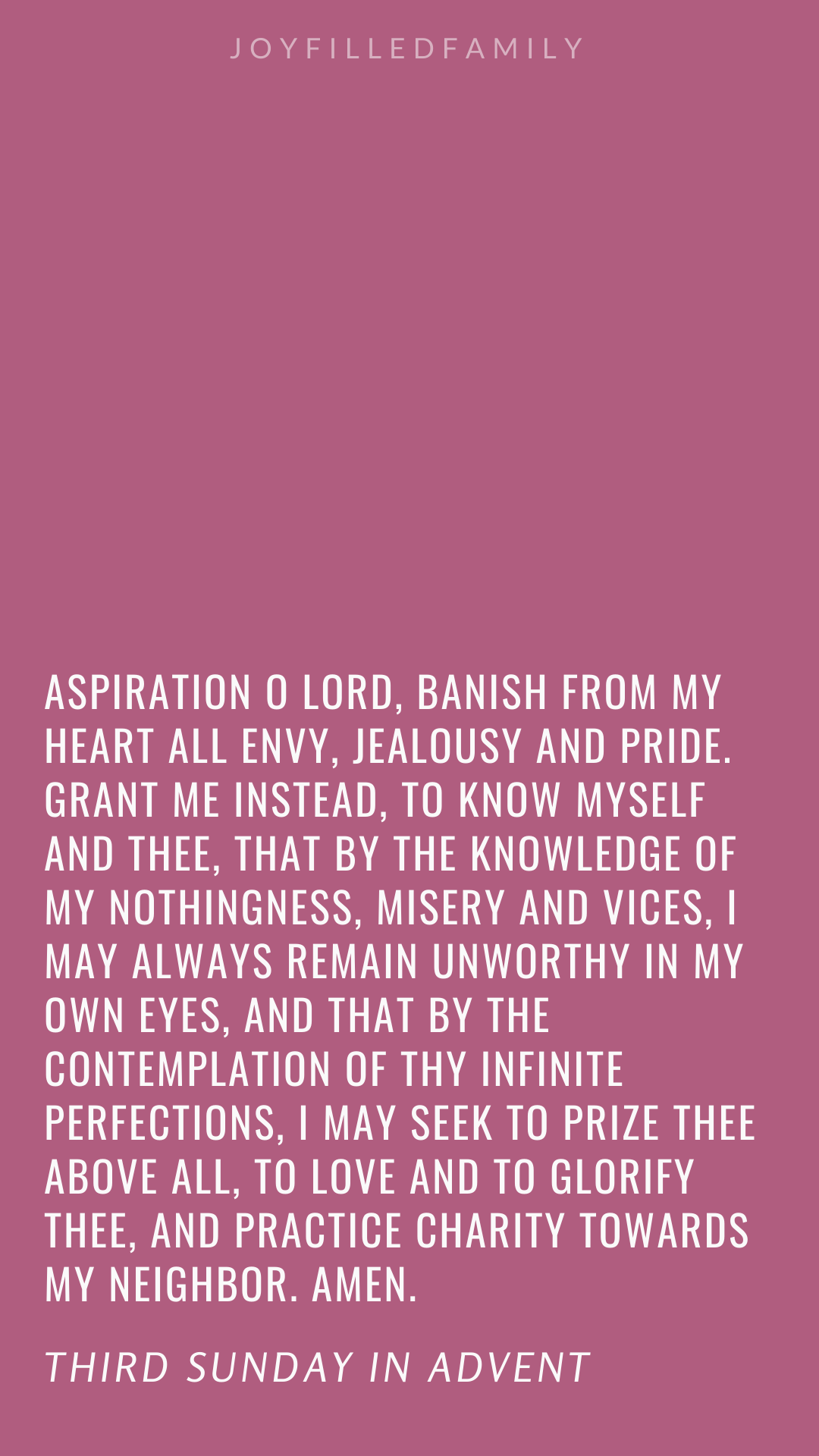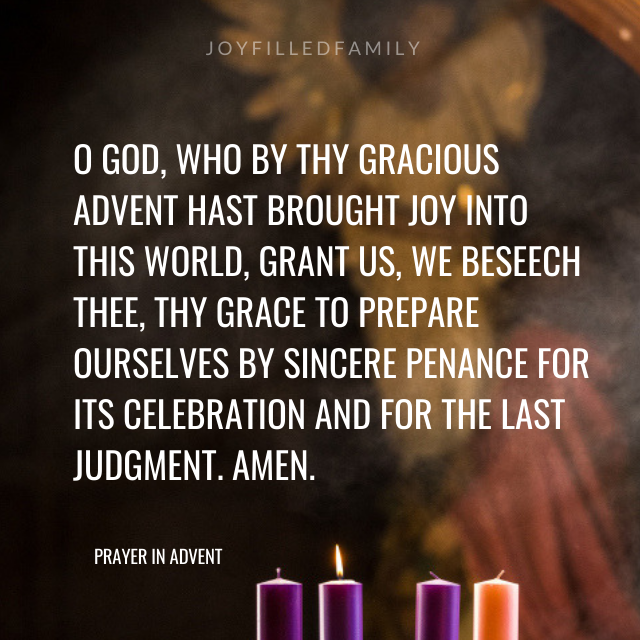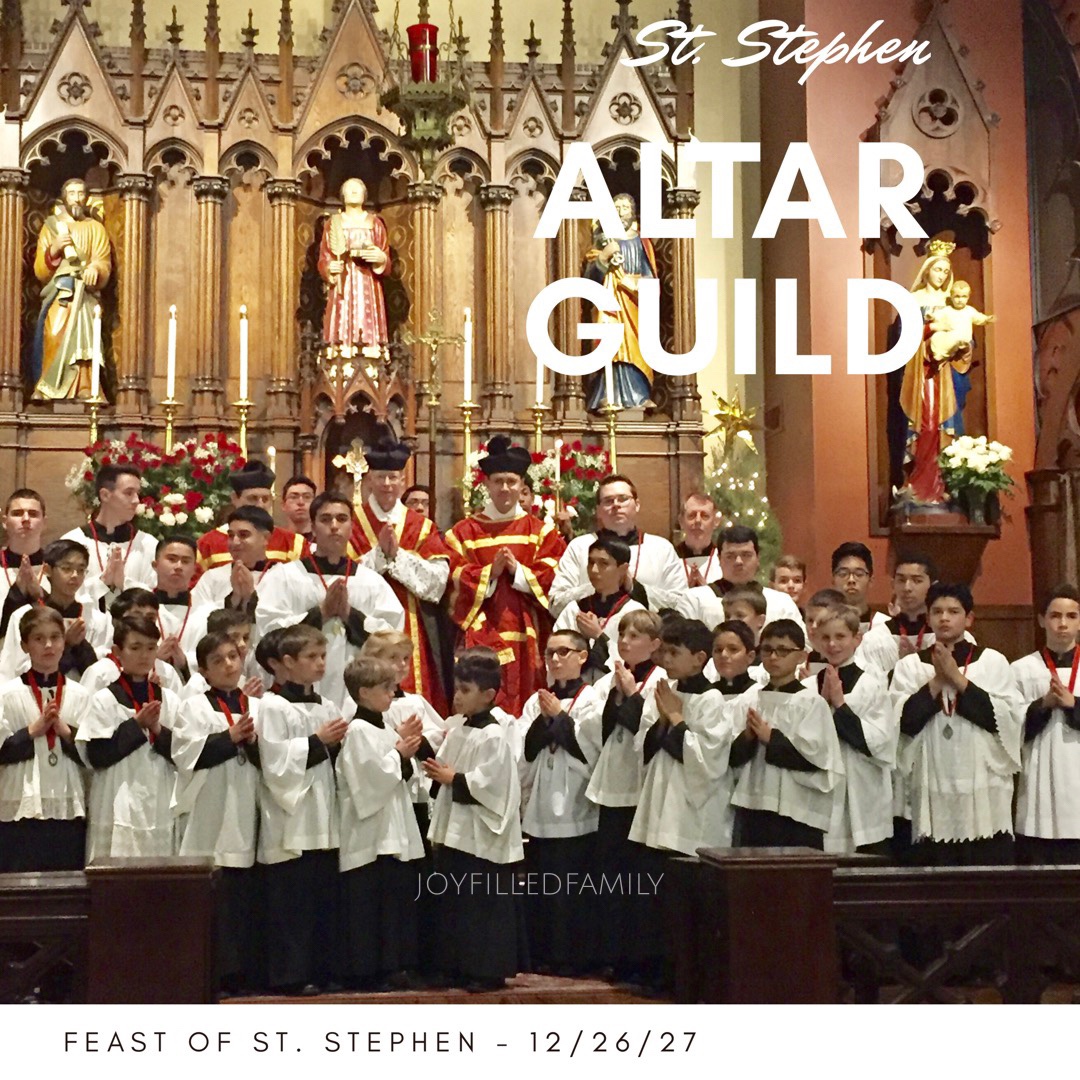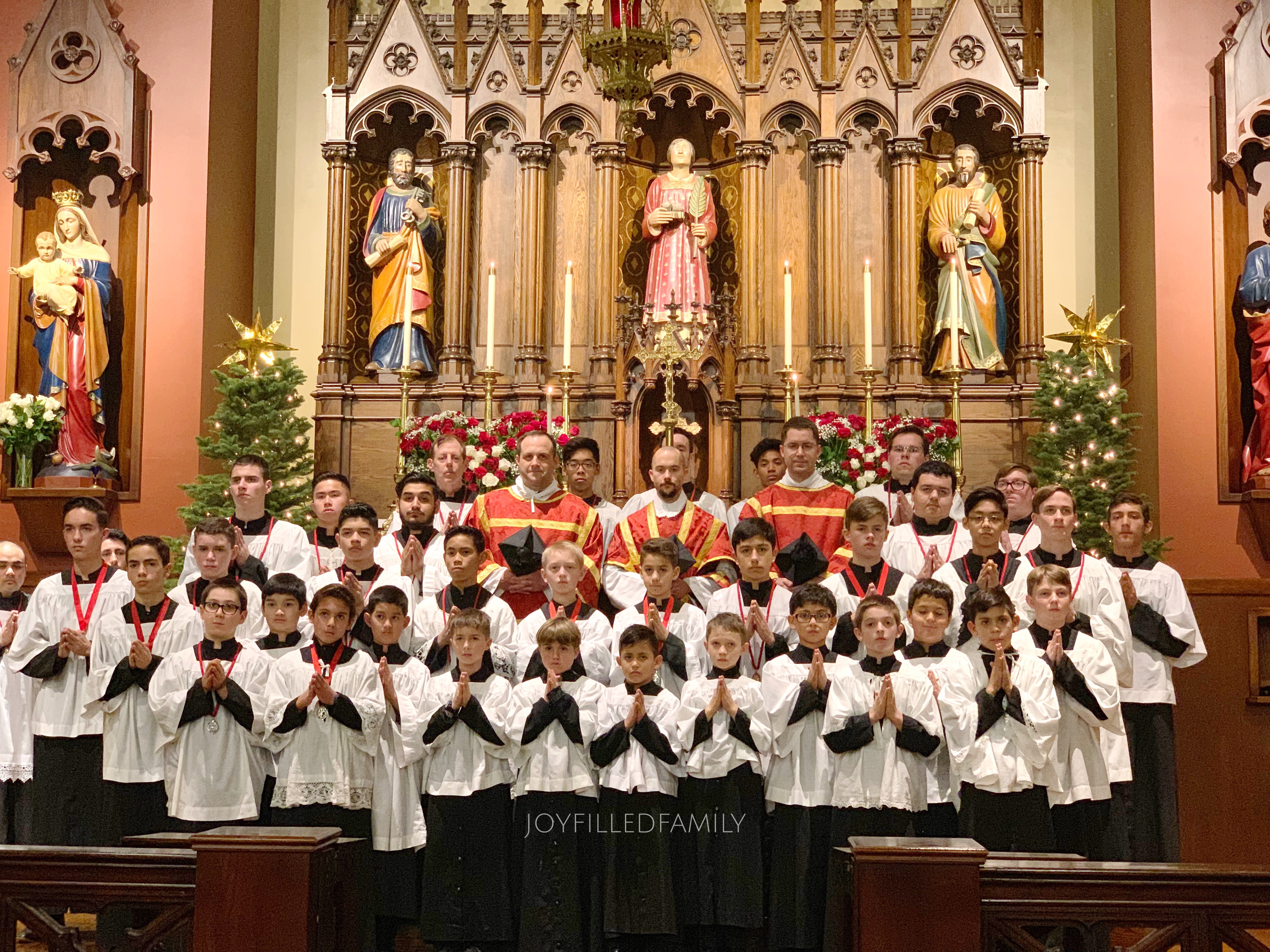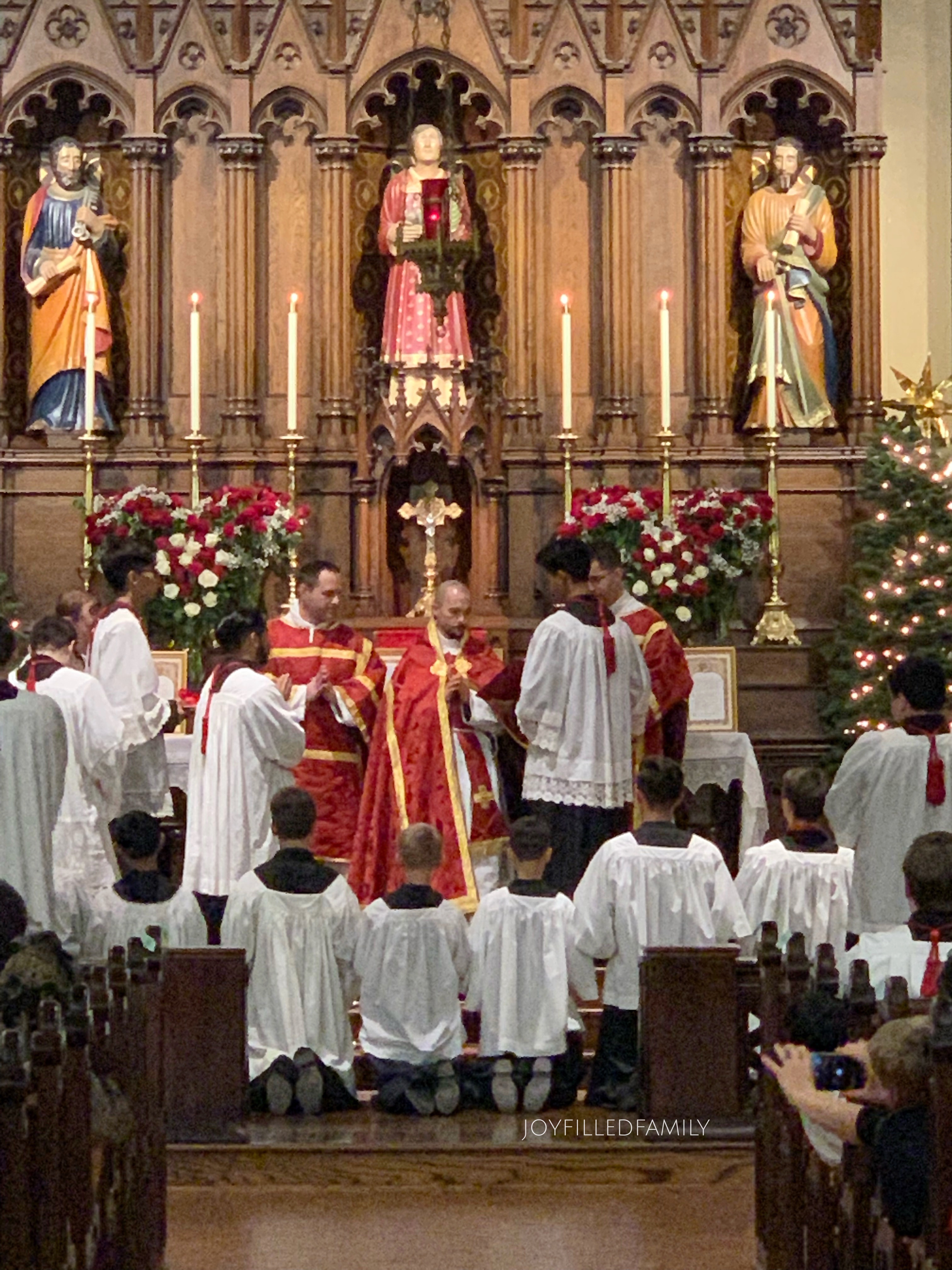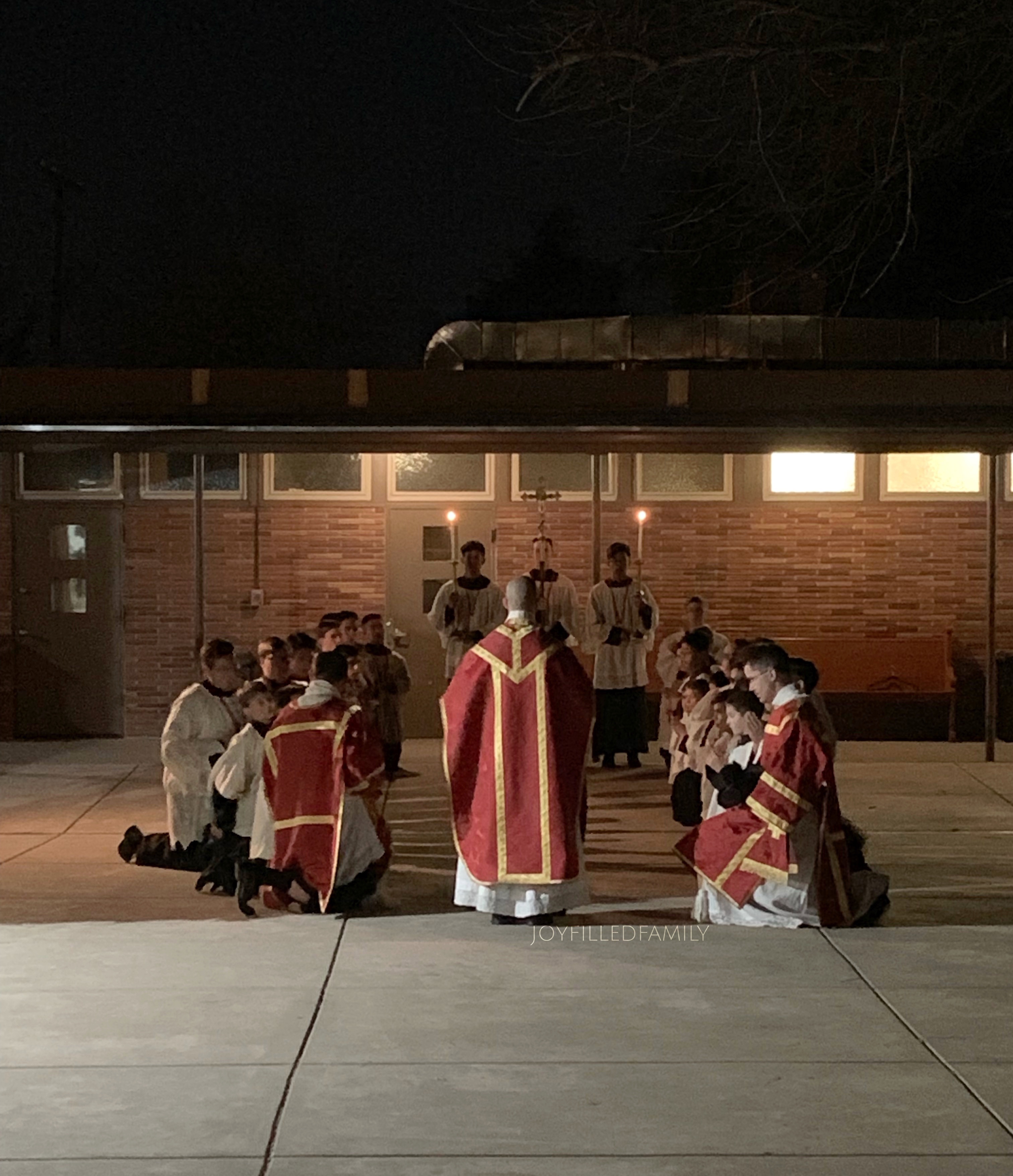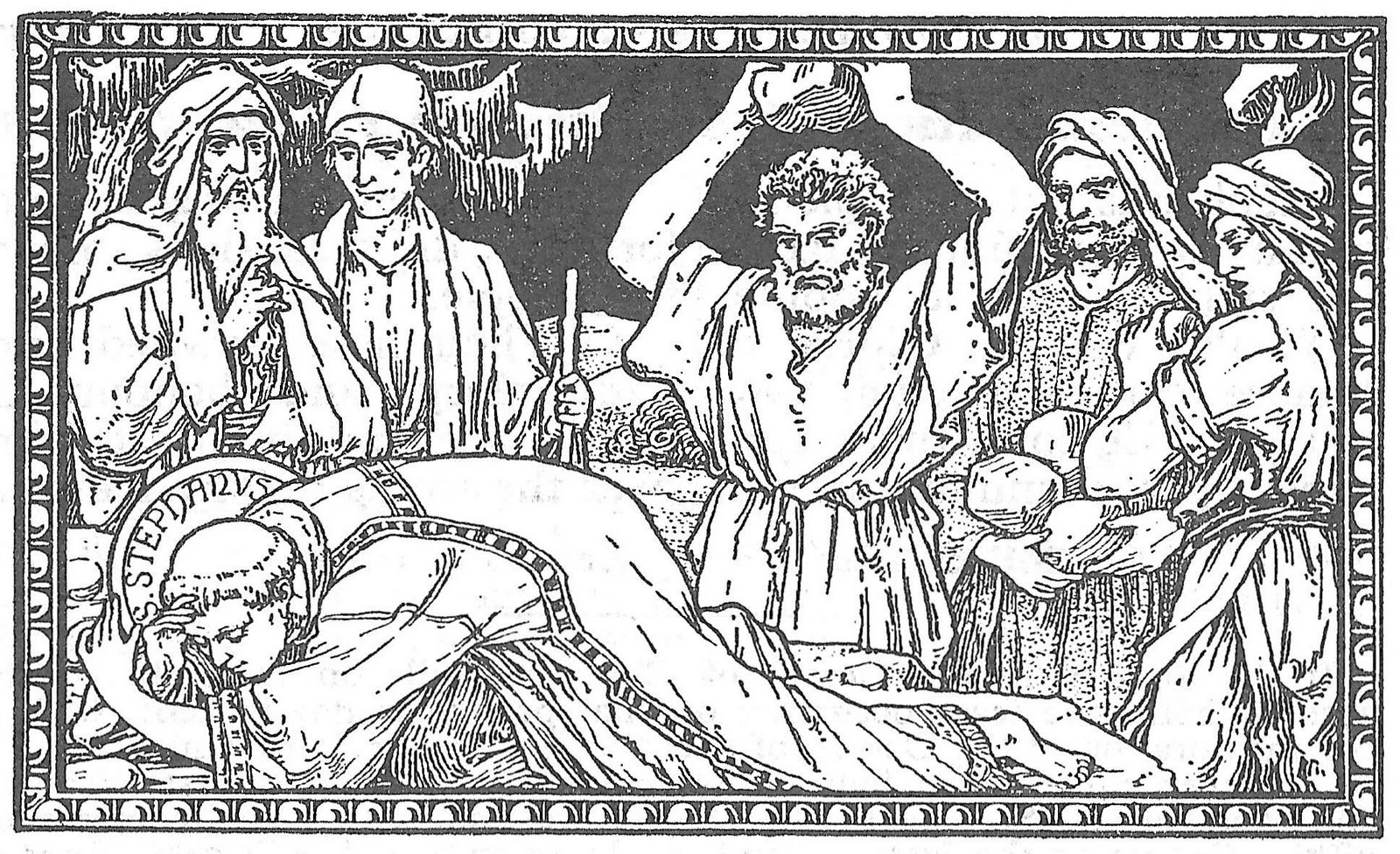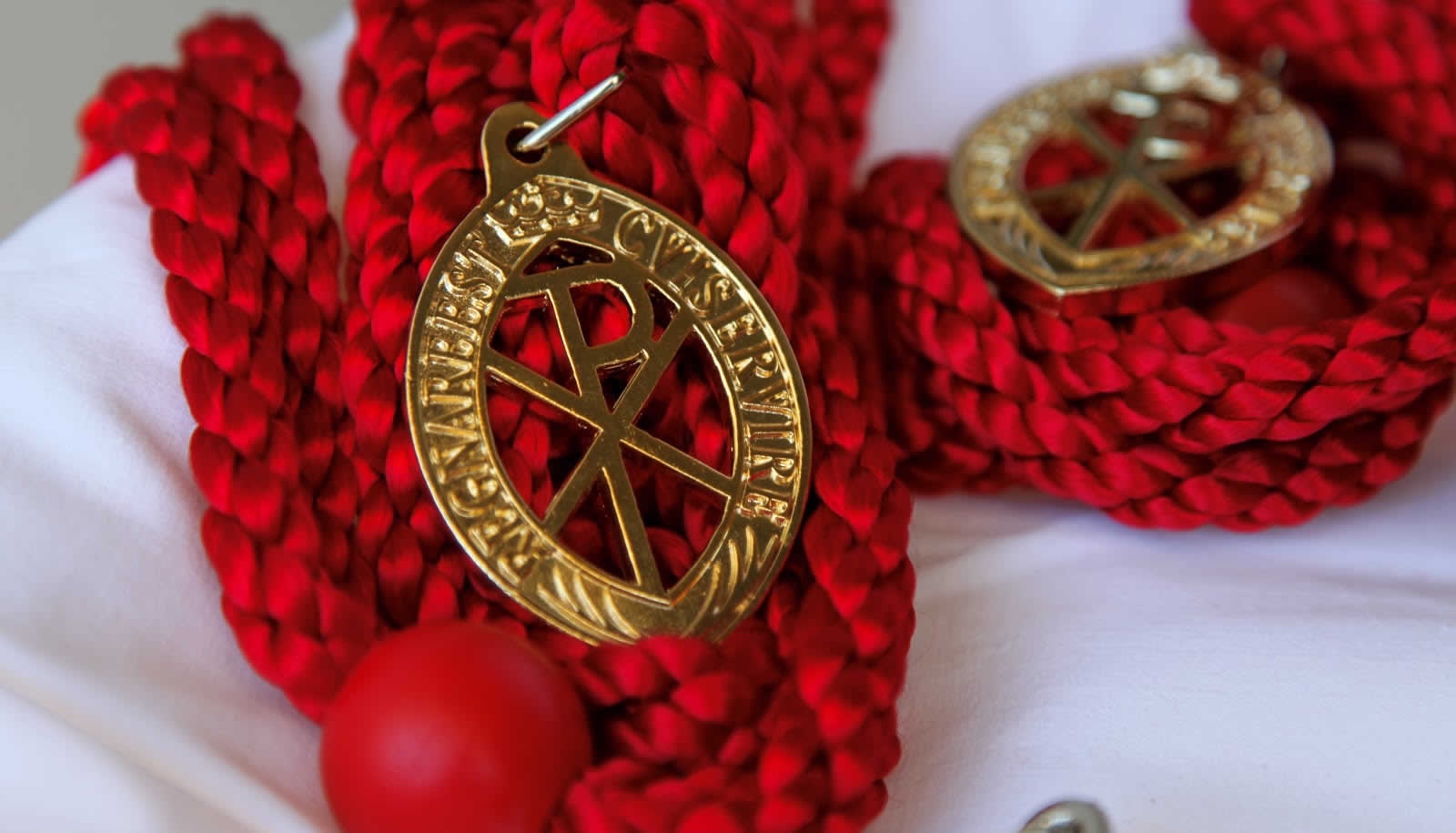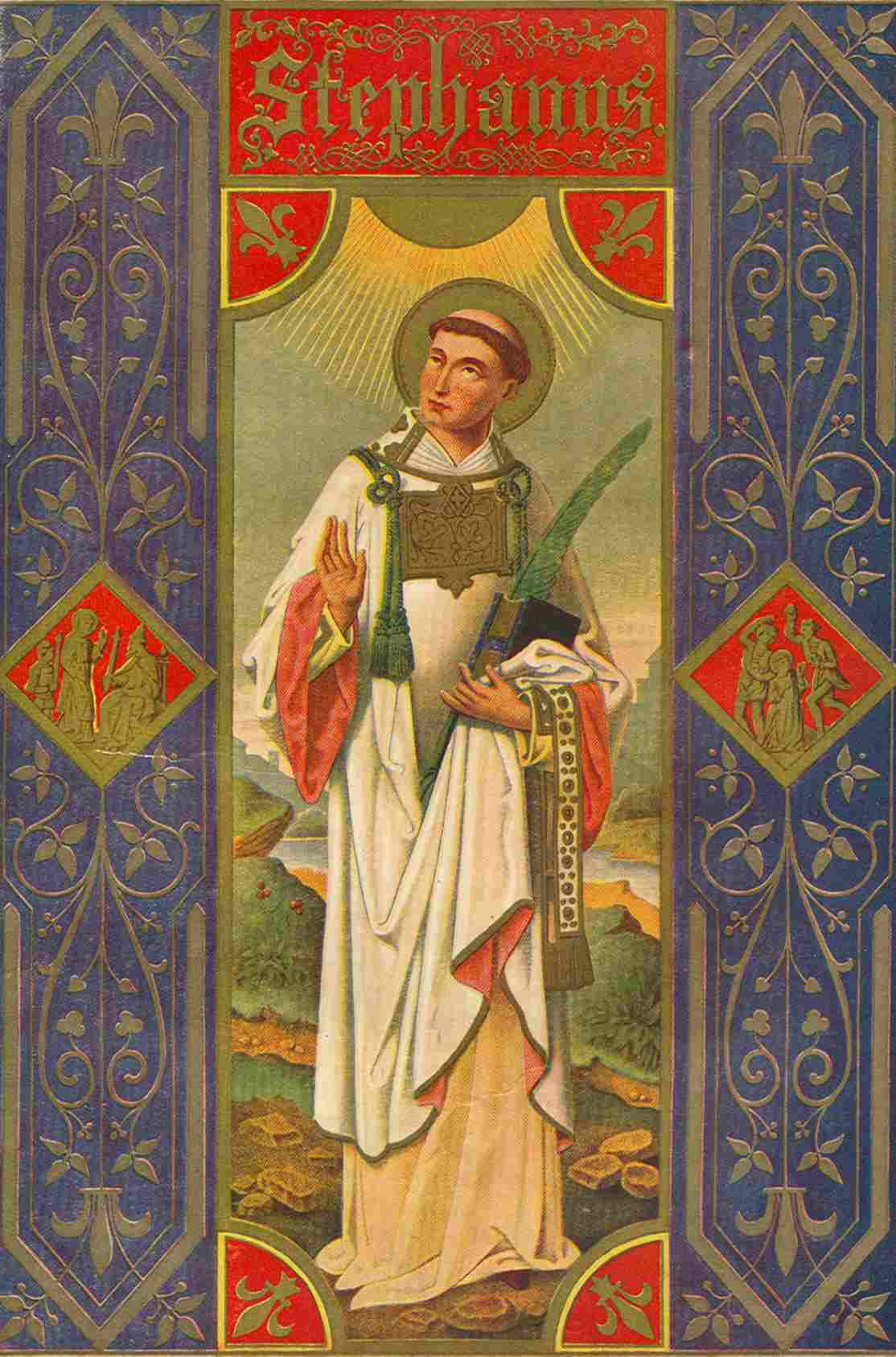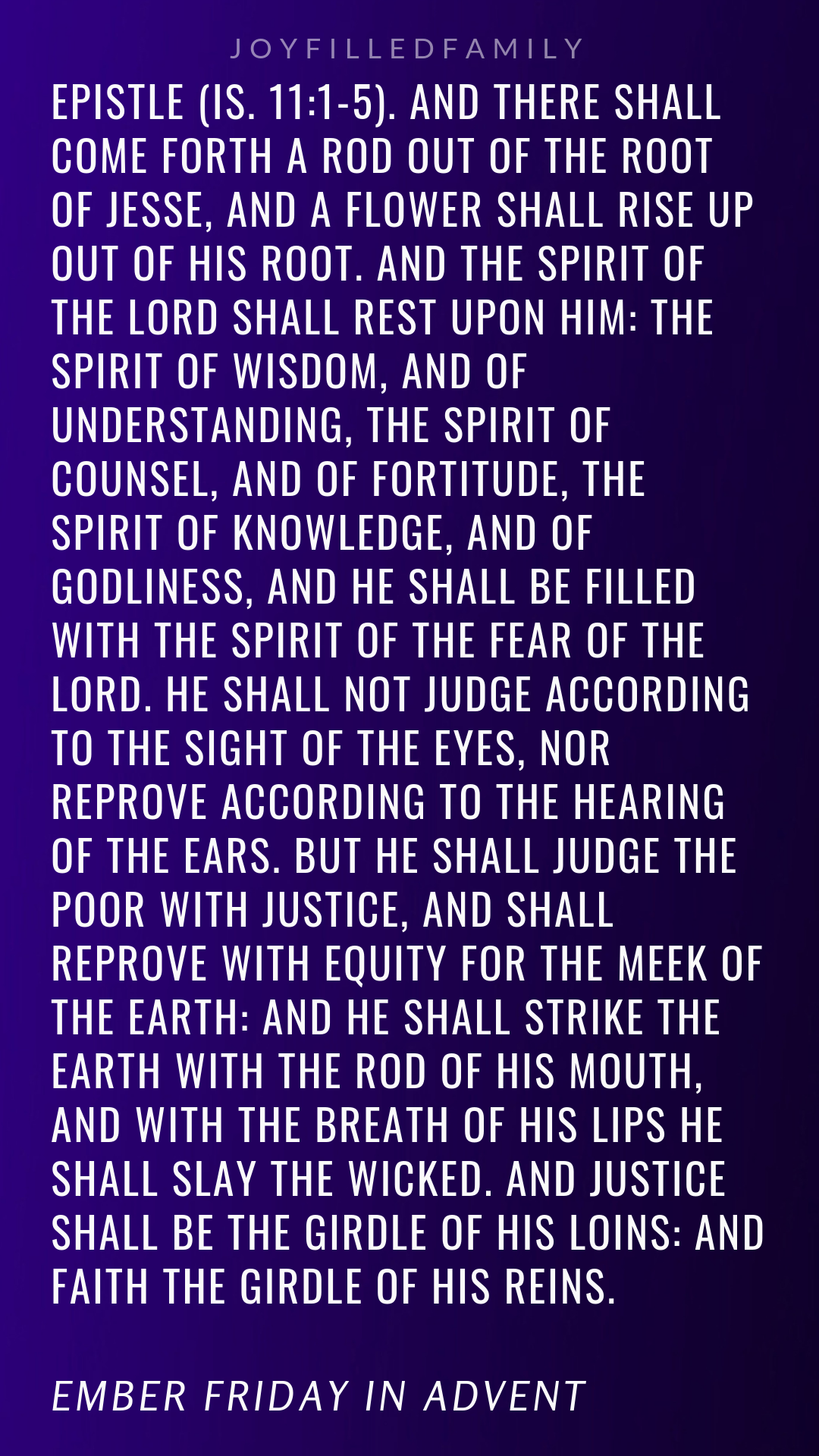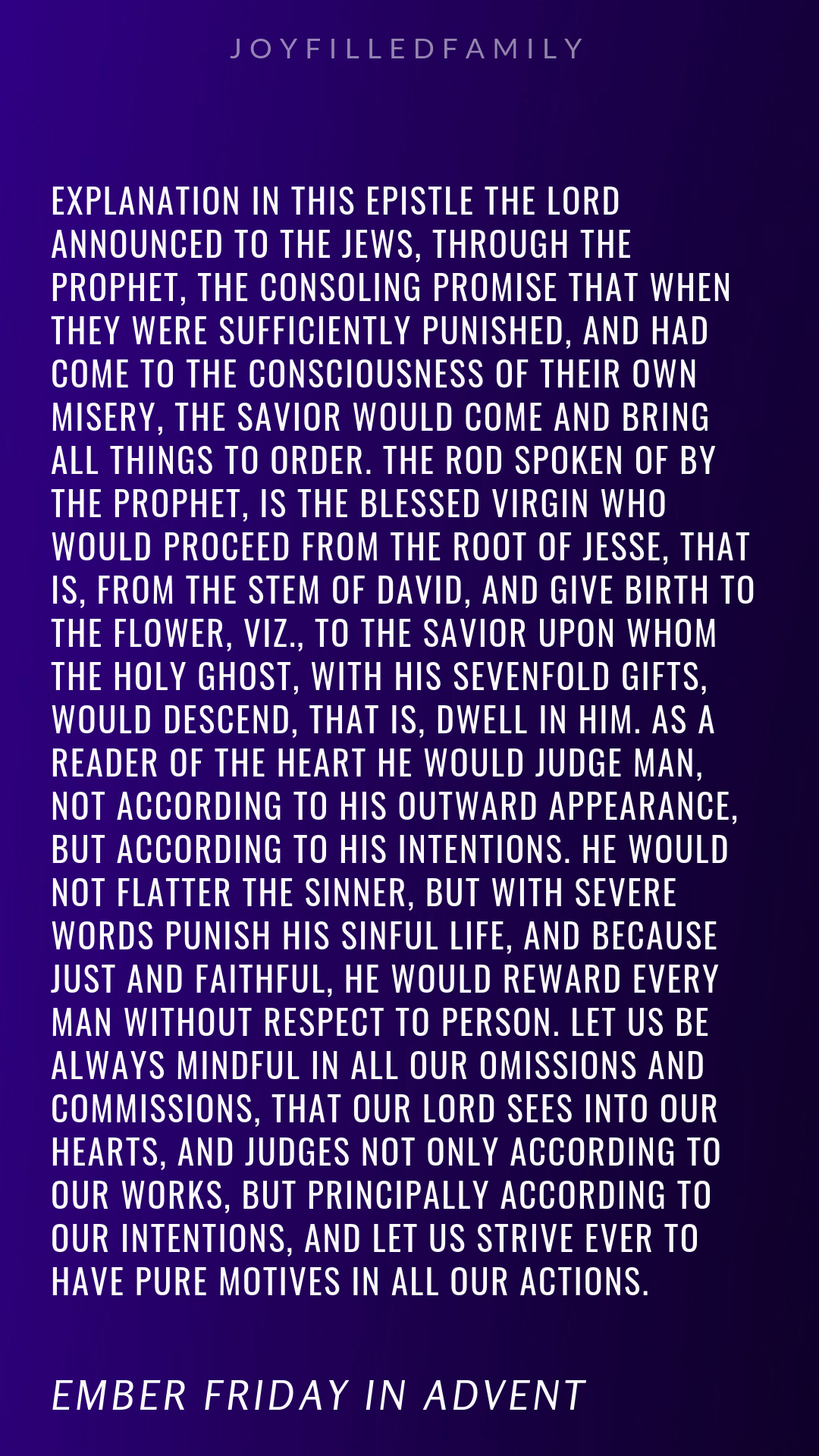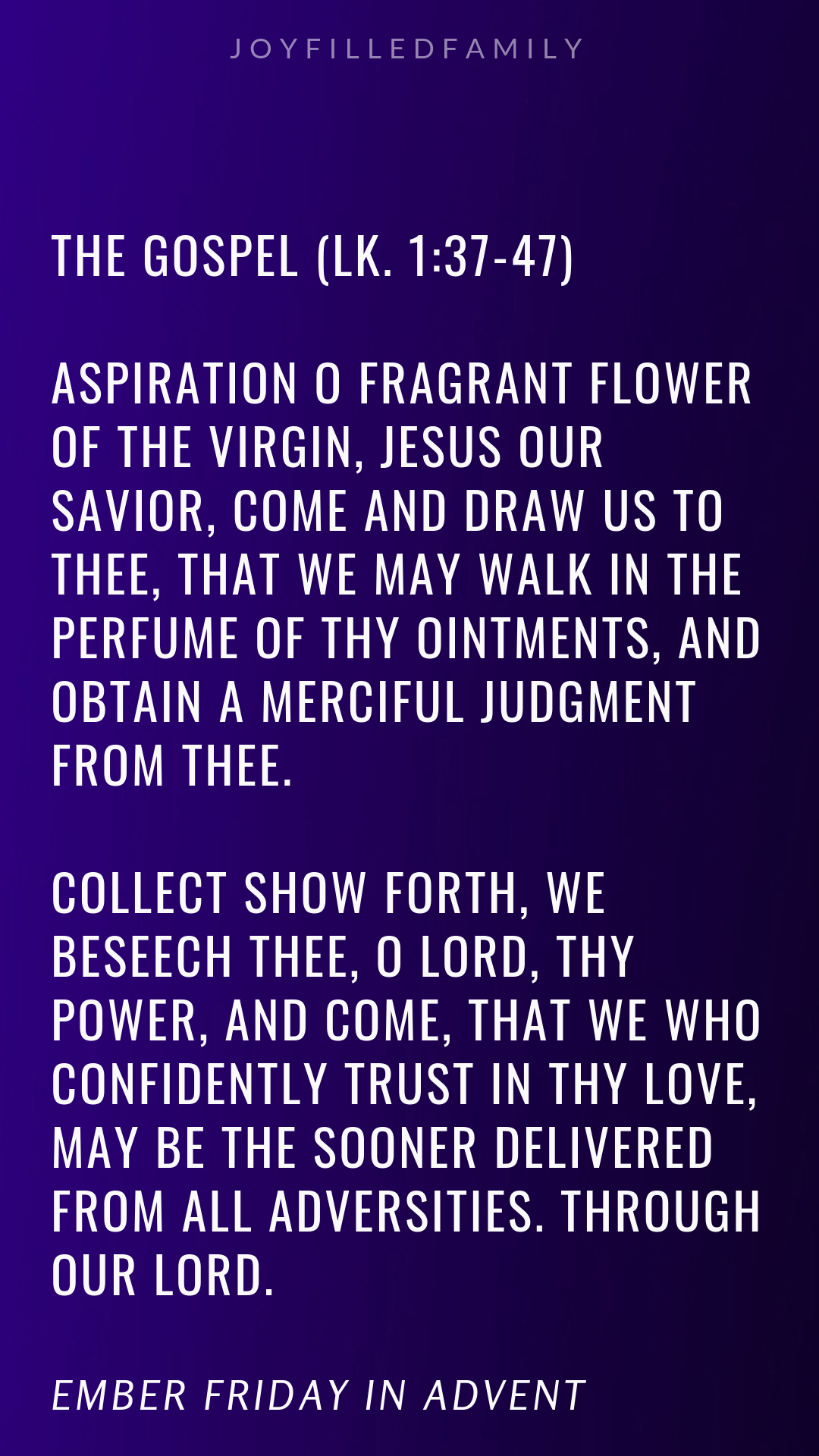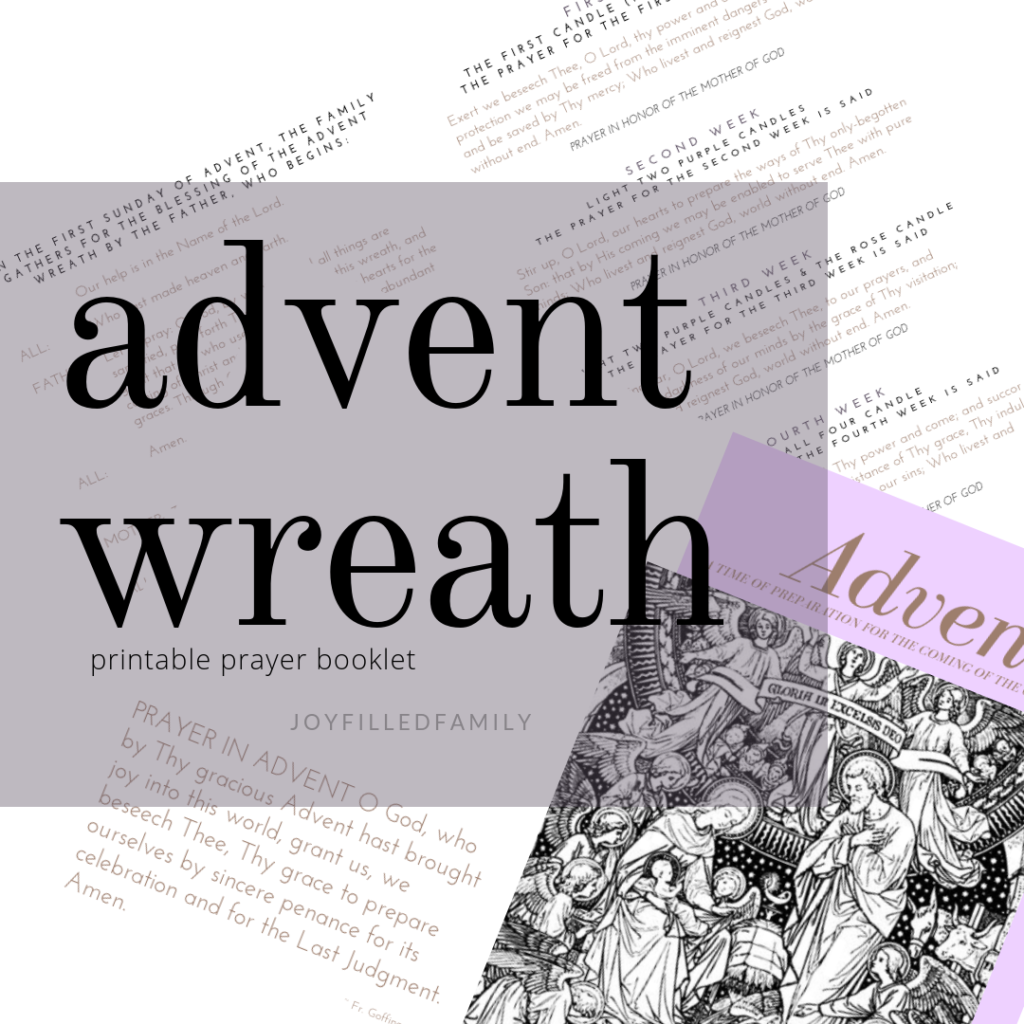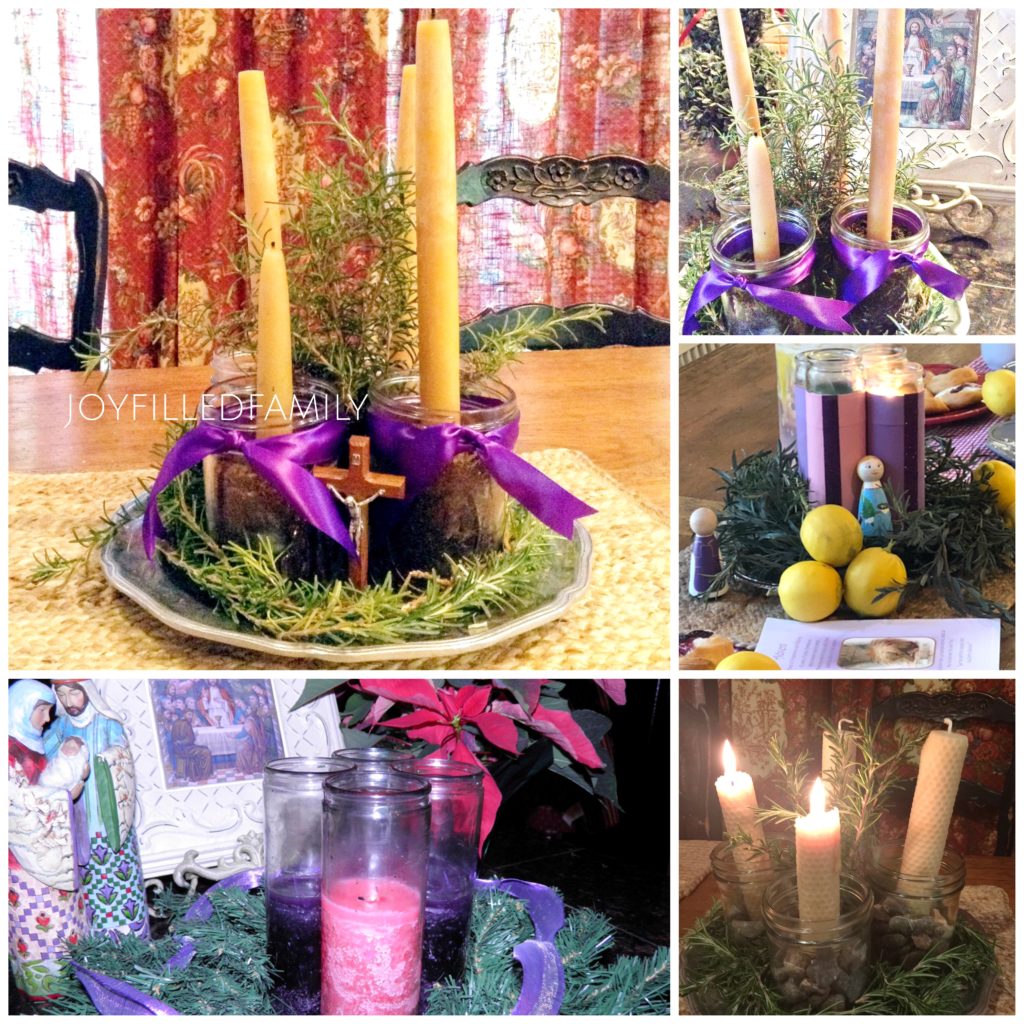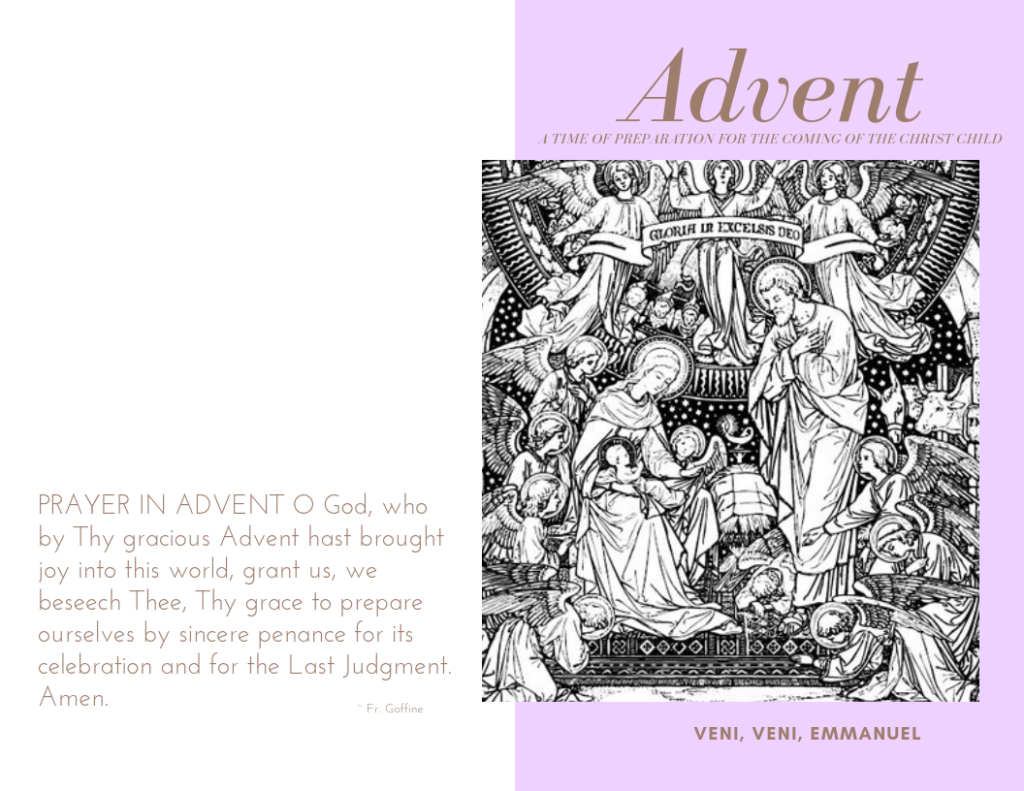Gaudete, Rejoice in the Lord Always
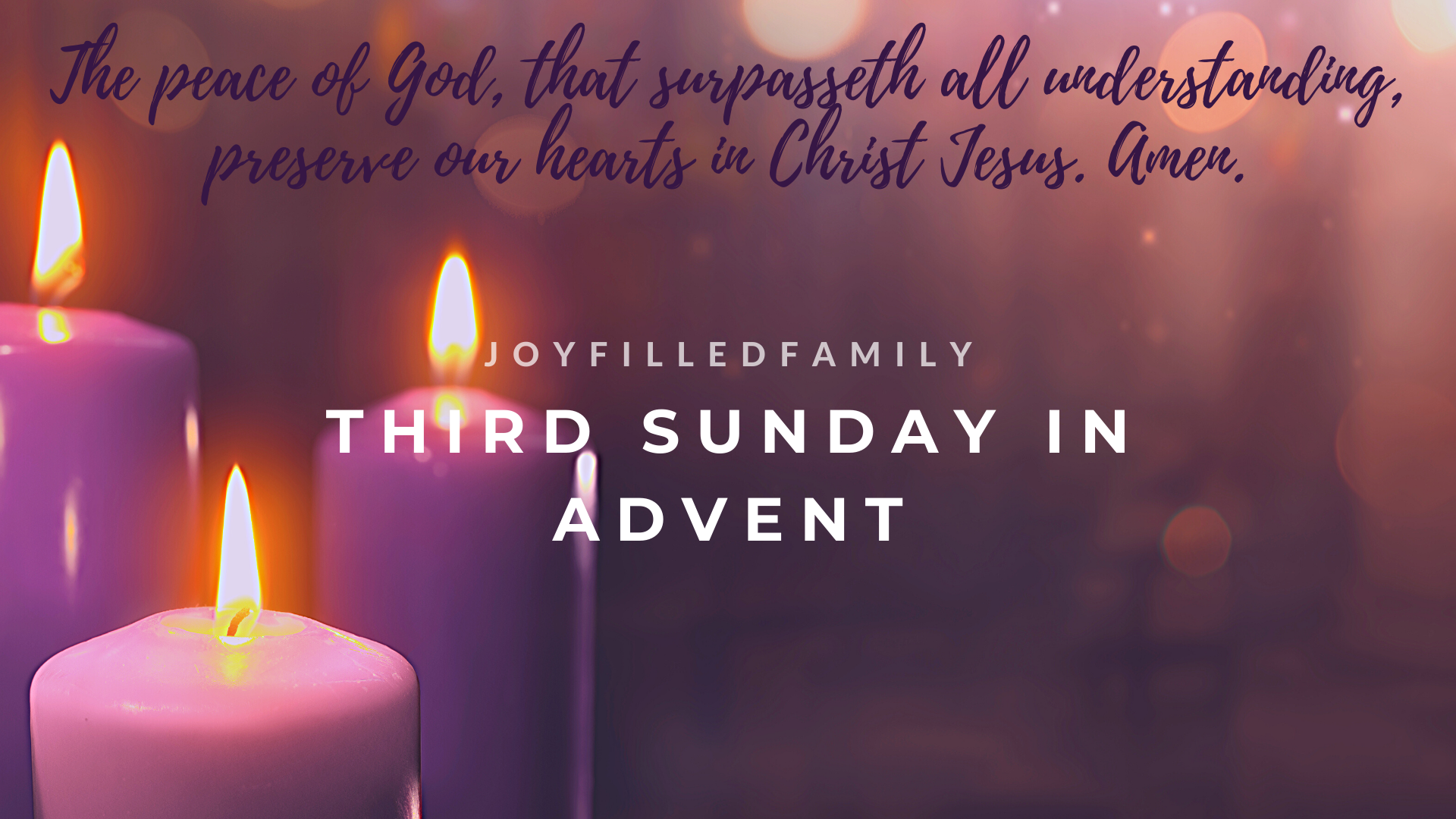
THIRD SUNDAY IN ADVENT
Fr. Goffine
On this Sunday again, the Church calls on us to rejoice in the Advent of the Redeemer, and at the Introit sings:
INTROIT Rejoice in the Lord always; again I say, rejoice. Let your modesty be known to all men: for the Lord is nigh. Be nothing solicitous; but in every thing by prayer let your requests be made known to God (Phil. 4). Lord, thou hast blessed thy land; thou hast turned away the captivity of Jacob (Ps. 84). Glory be to the Father.
COLLECT Incline Thine ear, O Lord, we beseech Thee, unto our prayers: and enlighten the darkness of our mind by the grace of thy visitation. Through our Lord.
EPISTLE (Phil. 4:4-7). Brethren, rejoice in the Lord always; again I say, rejoice. Let your modesty be known to all men. The Lord is nigh. Be nothing solicitous; but in everything, by prayer and supplication with thanksgiving, let your petitions be made known to God. And the peace of God, which surpasseth all understanding, keep your hearts and minds in Christ Jesus our Lord.
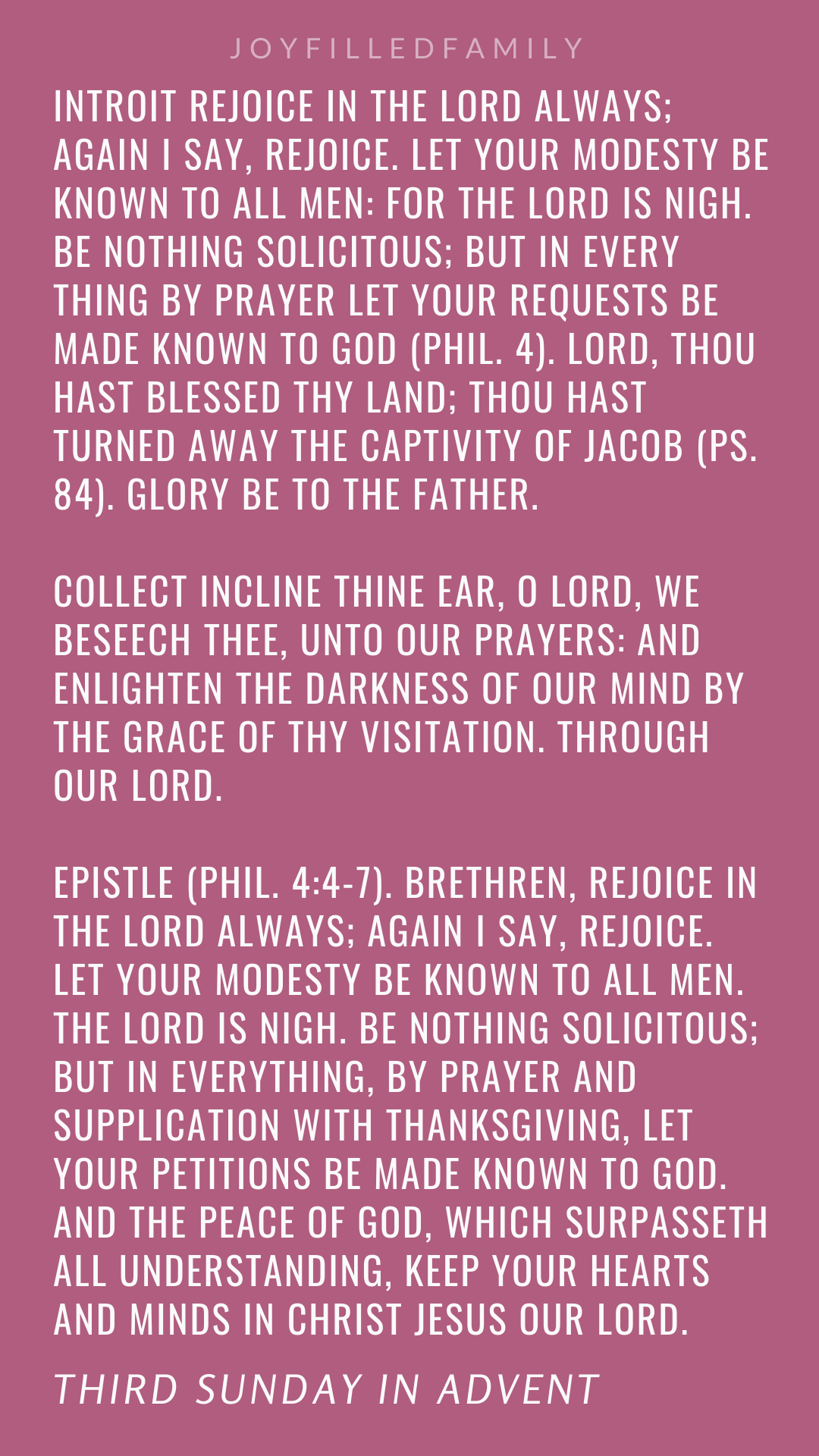
What is meant by “rejoicing in the Lord”?
By “rejoicing in the Lord” is meant rejoicing in the grace of the true faith we have received, in the hope of obtaining eternal happiness; rejoicing in the protection of the most High under which we stand; and in the persecution for justice’s sake in which Christ Himself exhorts us to rejoice, and in which the Apostle Paul gloried (II Cor. 7:4).
What else does St. Paul teach in this epistle?
He exhorts us to give all a good example by a modest and edifying life, to which we should be directed by the remembrance of God’s presence and His coming to judgment (Chrysostom. 33, in Joann.); he warns us against solicitude about temporal affairs, advising us to cast our care on God, who will never abandon us in our needs, if we entreat Him with confidence and humility.
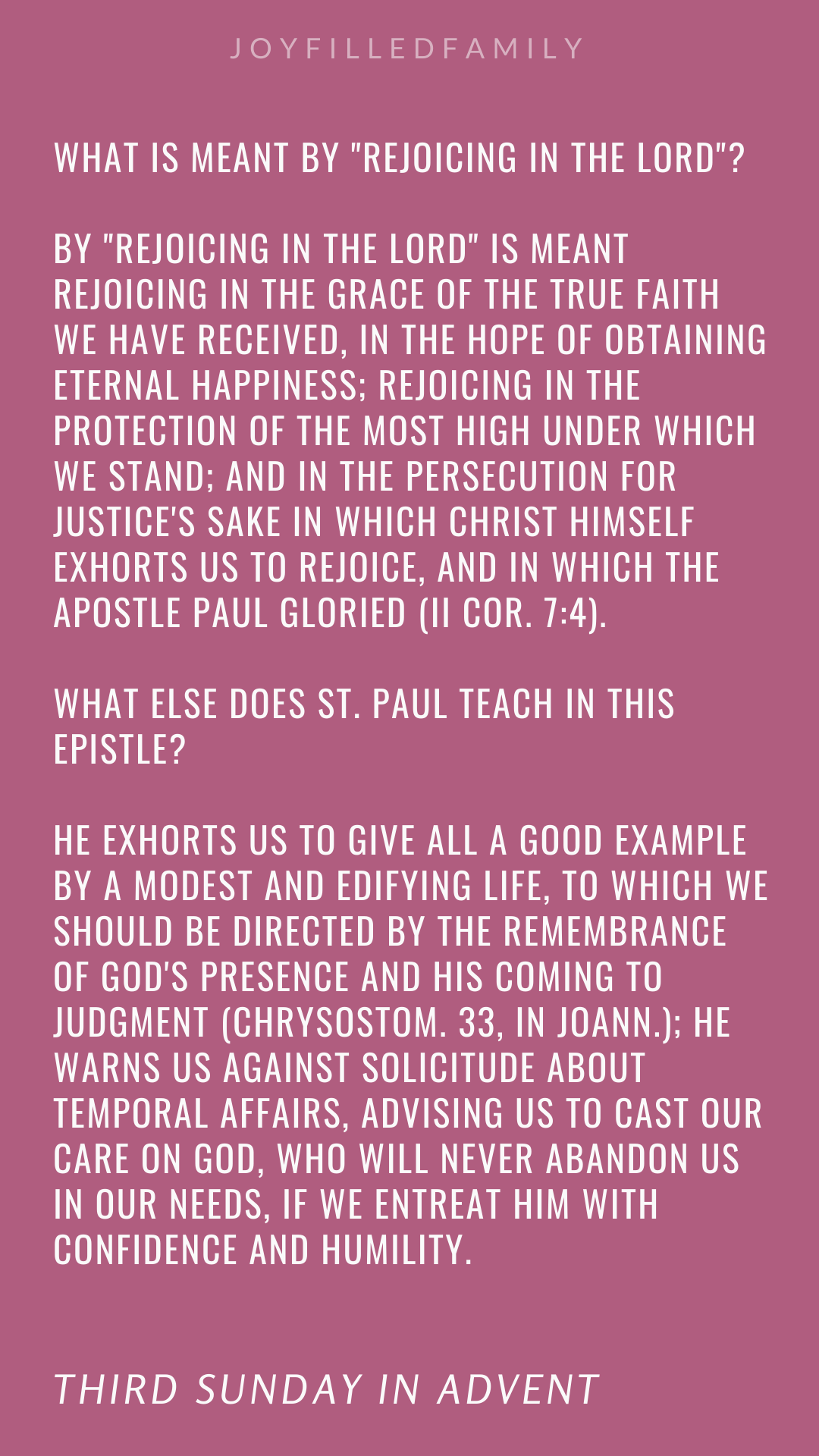
In what does “the Peace of God” consist?
It consists in a good conscience (Ambrose), in which St. Paul gloried and rejoiced beyond measure (II Cor. 1:12). This peace of the soul sustained all the martyrs, and consoled many others who suffered for justice’s sake. Thus St. Tibertius said to the tyrant: “We count all pain as naught, for our conscience is at peace.” There cannot be imagined a greater joy than that which proceeds from the peace of a good conscience. It must be experienced to be understood.
ASPIRATION The peace of God, that surpasseth all understanding, preserve our hearts in Christ Jesus. Amen.
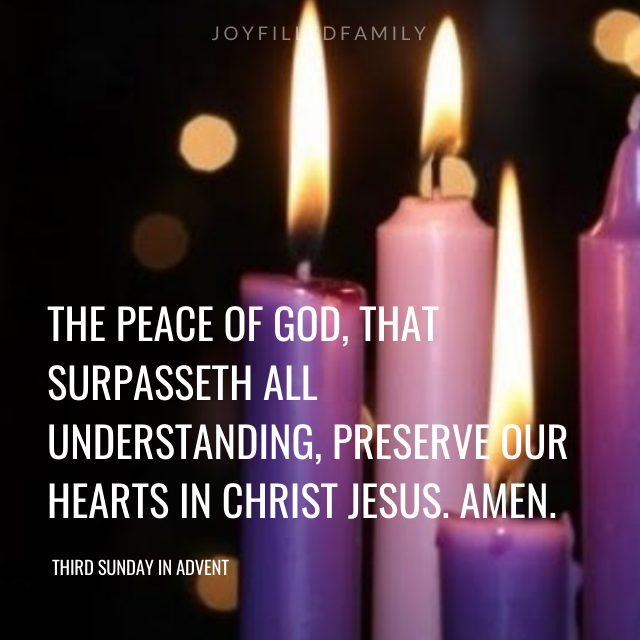
COMFORT AND RELIEF IN SORROW
“Is any one troubled, let him pray” (Jas. 5:13).
There is no greater or more powerful comfort in sorrow than in humble and confiding prayer, to complain to God of our wants and cares, as did the sorrowful Anna, mother of the prophet Samuel, (I Kings 10) and the chaste Susanna when she was falsely accused of adultery and sentenced to death (Dan. 13:35). So the pious King Ezechias complained in prayer of the severe oppression with which he was threatened by Senacherib (IV Kings 19:14). So also King Josaphat made his trouble known to God only, saying: But as we know not what to do, we can only turn our eyes on Thee (11 Para. 20:12). They all received aid and comfort from God. Are you sad and in trouble? Lift up your soul with David and say: To Thee I have lifted up my eyes, who dwellest in heaven. Behold as the eyes of servants are on the hands of their masters, as the eyes of the handmaid are on the hands of her mistress: so are our eyes unto the Lord our God, until He shall have mercy on us (Ps. 122:1-3). Give joy to the soul of Thy servant, for to Thee, O Lord, I have lifted up my soul (Ps. 85:4).
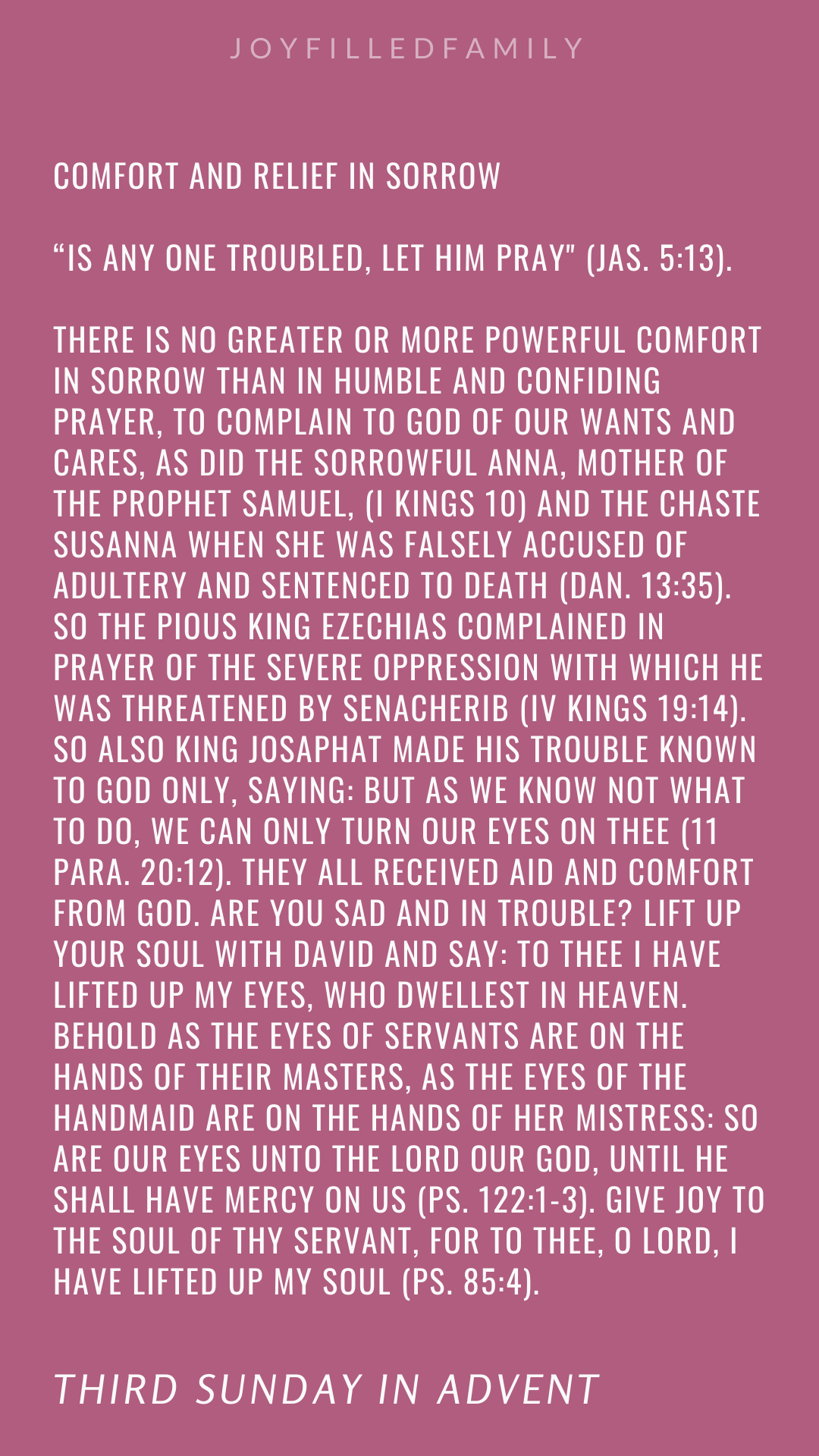
GOSPEL (Jn. 1:19-28). At that time the Jews sent from Jerusalem priests and Levites to John, to ask him, Who art thou? And he confessed, and did not deny; and he confessed: I am not the Christ. And they asked him, What then? Art thou Elias? And he said: I am not. Art thou the prophet? And he answered, No. They said therefore unto him, Who art thou, that we may give an answer to them that sent us? what sayst thou of thyself? He said, I am the voice of one crying in the wilderness, Make straight the way of the Lord, as said the prophet Isaias. And they that were sent were of the Pharisees. And they asked him, and said to him: Why then dost thou baptize, if thou be not Christ, nor Elias, nor the prophet? John answered them, saying: I baptize with water: but there hath stood one in the midst of you, whom you know not: the same is he that shall come after me, who is preferred before me, the latchet of whose shoe I am not worthy to loose. These things were done in Bethania beyond the Jordan, where John was baptizing.

Why did the Jews send messengers to St. John to ask him who he was?
Partly because of their curiosity, when they saw St. John leading such a pure, angelic and penitential life; partly, as St. Chrysostom says, out of envy, because St. John preached with such spiritual force, baptized and exhorted the people to penance, that the inhabitants of Jerusalem came to him in great numbers; partly, and principally, they were impelled by the providence of God to demand publicly of St. John, if he were the Messiah, and thus be directed to Christ that they might be compelled to acknowledge Him as the Messiah, or have no excuse for rejecting Him.
Why did the Jews ask St. John, if he were not Elias or the prophet?
The Jews falsely believed that the Redeemer was to come into this world but once, then with great glory, and that Elias or one of the old prophets would come before Him, to prepare His way, as Malachias (4:5) had prophesied of St. John; so when St. John said of himself that he was not the Messiah, they asked him, if he were not then Elias or one of the prophets. But Elias, who was taken alive from this world in a fiery chariot, will not reappear until just before the second coming of Christ.
Why did St. John say, he was not Elias or the Prophet?
Because he was not Elias, and, in reality, not a prophet in the Jewish sense of the word, but more than a prophet, because he announced that Christ had come, and pointed Him out.
Why does St. John call himself “the voice of one crying in the wilderness”?
Because in his humility, he desired to acknowledge that he was only an instrument through which the Redeemer announced to the abandoned and hopeless Jews the consolation of the Messiah, exhorting them to bear worthy fruits of penance.
How do we bear worthy fruits of penance?
We bear fruits of penance, when after our conversion, we serve God and justice with the same zeal with which we previously served the devil and iniquity; when we love God as fervently as we once loved the flesh – that is, the desires of the flesh – and the pleasures of the world; when we give our members to justice as we once gave them to malice and impurity (Rom. 6:19), when the mouth that formerly uttered improprieties, when the ears that listened to detraction or evil speech, when the eyes that looked curiously upon improper objects, now rejoice in the utterance of words pleasing to God, to hear and to see things dear to Him; when the appetite that was given to the luxury of eating and drinking, now abstains; when the hands give back what they have stolen; in a word, when we put off the old man, who was corrupted, and put on the new man, who is created in justice and holiness of truth (Eph. 4:22-24).
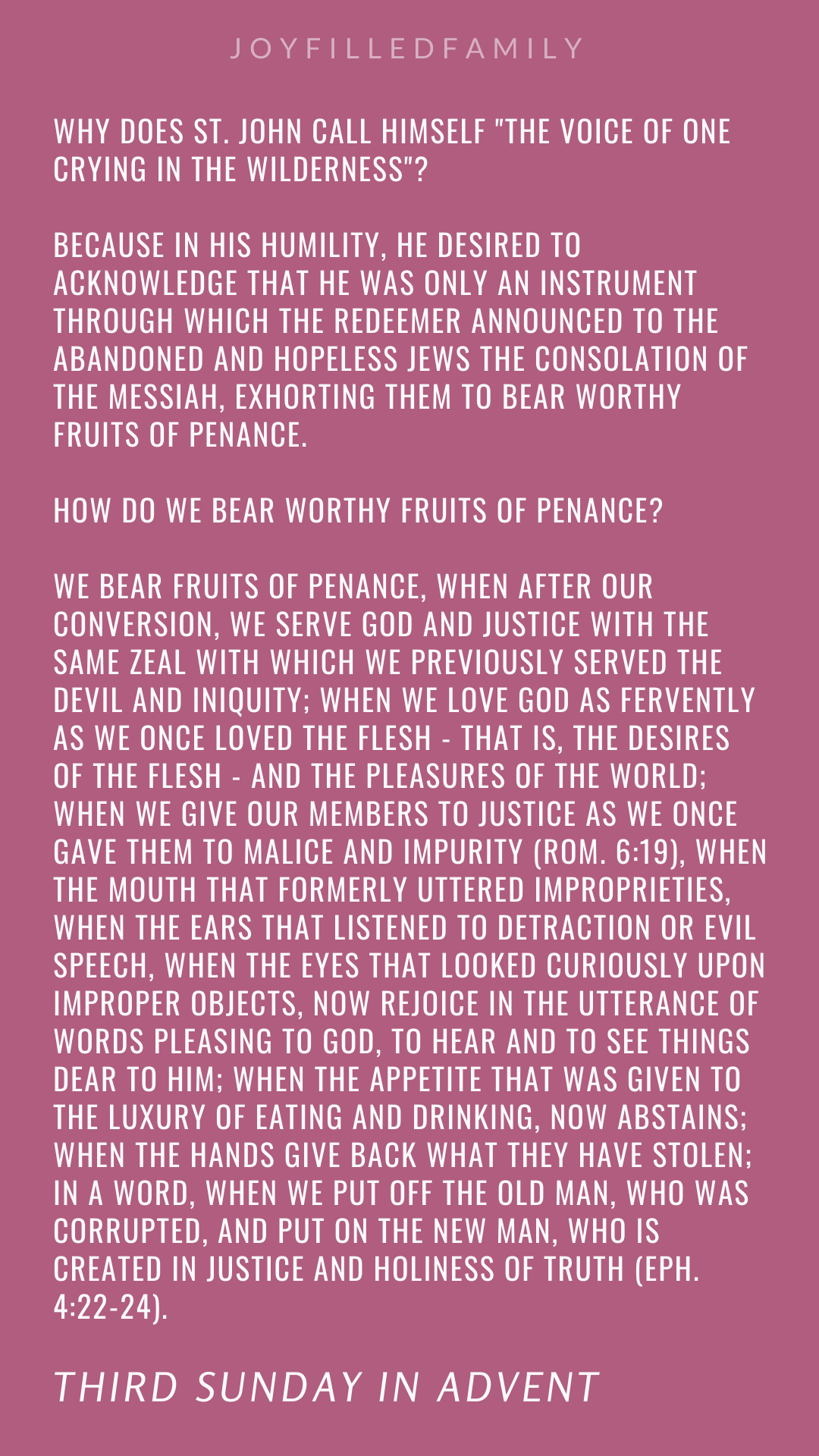
What was the baptism administered by St. John, and what were its effects?
The baptism administered by John was only a baptism of penance for forgiveness of sins (Lk. 3:3). The ignorant Jews not considering the greatness of their transgressions, St. John came exhorting them to acknowledge their sins, and do penance for them; that being converted, and truly contrite, they might seek their Redeemer, and thus obtain remission of their offences. We must then conclude, that St. John’s baptism was only a ceremony or initiation, by which the Jews enrolled themselves as his disciples to do penance, as a preparation for the remission of sin by means of the second baptism, viz., of Jesus Christ.
What else can be learned from this gospel?
We learn from it to be always sincere, especially at the tribunal of penance, and to practice the necessary virtue of humility, by which, in reply to the questions of the Jews, St. John confessed the truth openly and without reserve, as shown by the words: The latchet of whose shoe I am not worthy to loose, as the lowest of Christ’s servants, giving us an example of humility and sincerity, which should induce us always to speak the truth, and not only not to seek honor, but to give to God all the honor shown us by man. Have you not far more reason than John, who was such a great saint, to esteem yourself but little, and to humble yourself before God and man? “My son,” says Tobias (4:14), “never suffer pride to reign in thy mind, or in thy words: for from it all perdition took its beginning.”
ASPIRATION O Lord, banish from my heart all envy, jealousy and pride. Grant me instead, to know myself and Thee, that by the knowledge of my nothingness, misery and vices, I may always remain unworthy in my own eyes, and that by the contemplation of Thy infinite perfections, I may seek to prize Thee above all, to love and to glorify Thee, and practice charity towards my neighbor. Amen.
